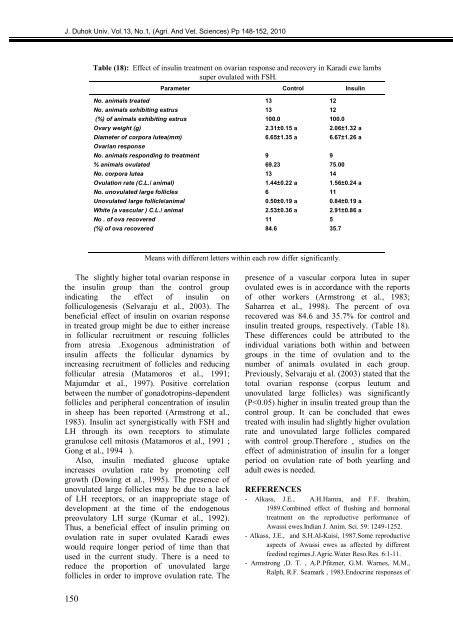The Influence Of Priming Two Cucumber Cultivar Seeds
The Influence Of Priming Two Cucumber Cultivar Seeds
The Influence Of Priming Two Cucumber Cultivar Seeds
Create successful ePaper yourself
Turn your PDF publications into a flip-book with our unique Google optimized e-Paper software.
J. Duhok Univ. Vol.13, No.1, (Agri. And Vet. Sciences) Pp 148-152, 2010<br />
851<br />
Table (18): Effect of insulin treatment on ovarian response and recovery in Karadi ewe lambs<br />
super ovulated with FSH.<br />
No. animals treated<br />
No. animals exhibiting estrus<br />
(%) of animals exhibiting estrus<br />
Ovary weight (g)<br />
Diameter of corpora lutea(mm)<br />
Ovarian response<br />
No. animals responding to treatment<br />
% animals ovulated<br />
No. corpora lutea<br />
Ovulation rate (C.L./ animal)<br />
No. unovulated large follicles<br />
Unovulated large follicle/animal<br />
White (a vascular ) C.L./ animal<br />
No . of ova recovered<br />
(%) of ova recovered<br />
Parameter Control Insulin<br />
13<br />
13<br />
100.0<br />
2.31±0.15 a<br />
6.65±1.35 a<br />
9<br />
69.23<br />
13<br />
1.44±0.22 a<br />
6<br />
0.50±0.19 a<br />
2.53±0.36 a<br />
11<br />
84.6<br />
12<br />
12<br />
100.0<br />
2.06±1.32 a<br />
6.67±1.26 a<br />
9<br />
75.00<br />
14<br />
1.56±0.24 a<br />
11<br />
0.84±0.19 a<br />
2.91±0.86 a<br />
5<br />
35.7<br />
Means with different letters within each row differ significantly.<br />
<strong>The</strong> slightly higher total ovarian response in<br />
the insulin group than the control group<br />
indicating the effect of insulin on<br />
folliculogenesis (Selvaraju et al., 2003). <strong>The</strong><br />
beneficial effect of insulin on ovarian response<br />
in treated group might be due to either increase<br />
in follicular recruitment or rescuing follicles<br />
from atresia .Exogenous administration of<br />
insulin affects the follicular dynamics by<br />
increasing recruitment of follicles and reducing<br />
follicular atresia (Matamoros et al., 1991;<br />
Majumdar et al., 1997). Positive correlation<br />
between the number of gonadotropins-dependent<br />
follicles and peripheral concentration of insulin<br />
in sheep has been reported (Armstrong et al.,<br />
1983). Insulin act synergistically with FSH and<br />
LH through its own receptors to stimulate<br />
granulose cell mitosis (Matamoros et al., 1991 ;<br />
Gong et al., 1994 ).<br />
Also, insulin mediated glucose uptake<br />
increases ovulation rate by promoting cell<br />
growth (Dowing et al., 1995). <strong>The</strong> presence of<br />
unovulated large follicles may be due to a lack<br />
of LH receptors, or an inappropriate stage of<br />
development at the time of the endogenous<br />
preovulatory LH surge (Kumar et al., 1992).<br />
Thus, a beneficial effect of insulin priming on<br />
ovulation rate in super ovulated Karadi ewes<br />
would require longer period of time than that<br />
used in the current study. <strong>The</strong>re is a need to<br />
reduce the proportion of unovulated large<br />
follicles in order to improve ovulation rate. <strong>The</strong><br />
presence of a vascular corpora lutea in super<br />
ovulated ewes is in accordance with the reports<br />
of other workers (Armstrong et al., 1983;<br />
Saharrea et al., 1998). <strong>The</strong> percent of ova<br />
recovered was 84.6 and 35.7% for control and<br />
insulin treated groups, respectively. (Table 18).<br />
<strong>The</strong>se differences could be attributed to the<br />
individual variations both within and between<br />
groups in the time of ovulation and to the<br />
number of animals ovulated in each group.<br />
Previously, Selvaraju et al. (2003) stated that the<br />
total ovarian response (corpus leutum and<br />
unovulated large follicles) was significantly<br />
(P



